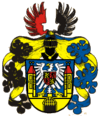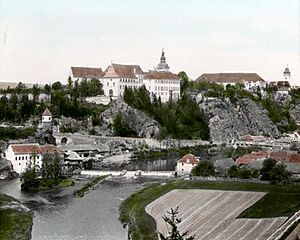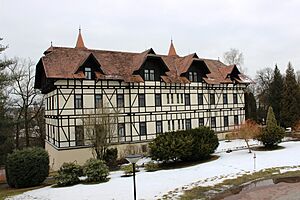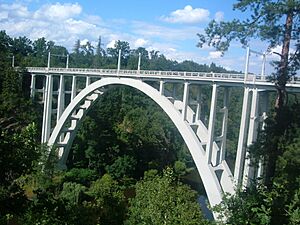Bechyně facts for kids
Quick facts for kids
Bechyně
|
|||
|---|---|---|---|
|
Town
|
|||
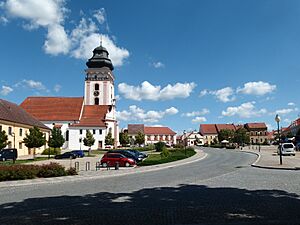
T. G. Masaryka Square with the Church of Saint Matthew
|
|||
|
|||
| Country | |||
| Region | South Bohemian | ||
| District | Tábor | ||
| First mentioned | 993 | ||
| Area | |||
| • Total | 21.29 km2 (8.22 sq mi) | ||
| Elevation | 406 m (1,332 ft) | ||
| Population
(2024-01-01)
|
|||
| • Total | 4,838 | ||
| • Density | 227.24/km2 (588.56/sq mi) | ||
| Time zone | UTC+1 (CET) | ||
| • Summer (DST) | UTC+2 (CEST) | ||
| Postal code |
391 65
|
||
Bechyně is a charming town in the Czech Republic. It is located in the South Bohemian Region. About 4,800 people live here. The historic town center is very special. It is protected by law as an important monument zone.
Contents
Where is Bechyně?
Bechyně is about 19 kilometers (12 miles) southwest of Tábor. It is also about 34 kilometers (21 miles) north of České Budějovice. The town sits on a high piece of land. This land is above where the Lužnice River and Smutná Brook meet. Another small stream, Židova strouha, also flows into the river nearby.
A Look at Bechyně's Past
People have lived in the Bechyně area for a very long time. The oldest signs of settlement are from the late Bronze Age. This was around 1800–1600 BC. In the 8th or 9th century, a Slavic fort was built here.
The first time Bechyně was written about was around 1120. It mentioned the fort being settled in 993. In 1268, King Ottokar II of Bohemia bought Bechyně. He decided to build a strong stone castle there. Later, in 1323, King John of Bohemia made the market village around the castle into a town. He also had walls built to protect it.
The town faced tough times during the Hussite Wars. It was captured and burned in 1422 and again in 1428. For many years, different noble families owned the town. In 1569, Peter Vok of Rosenberg took over Bechyně. Under his rule, the town became very grand. The castle was rebuilt in a beautiful Renaissance style.
Bechyně was damaged during the Thirty Years' War. But the town recovered and grew. In the 1700s, it started to become known as a spa town.
What Bechyně is Known For
Bechyně is famous for a few things. It has a long history of making ceramics. It is also known for its healing spa.
Ceramic Art and Industry
Making pottery and ceramics started in Bechyně in the 15th century. Back then, there were small pottery shops. This tradition grew over time. Now, it includes a large factory that makes sanitary ceramics.
The Bechyně Spa
Bechyně Spa is one of the oldest spas in the Czech Republic. People first heard about its healing spring in 1576. The first spa house was built in 1647. In 1727, scientists proved the water had healing effects. Later, in 1939, they found that local peat (a type of mud) also helped.
Today, the spa helps people with body treatments. They use special therapeutic mud. It helps with conditions like arthritis and osteoarthritis. It also helps with joint problems, nerve issues, and recovery after surgery.
Getting Around Bechyně
Bechyně is the end point of the Tábor–Bechyně railway line. This railway was built in 1903. It was the very first electrified railway in the Austria-Hungary region. You can still ride a special old passenger train on this line in the summer.
There is also a unique bridge in Bechyně. It is called the Bechyně Bridge. This bridge is special because both trains and cars can use it.
Learning in Bechyně
Bechyně has the oldest vocational school for ceramics in Bohemia. It is still teaching students today. Many famous people studied there. These include actors like Karel Roden and Jan Kačer, and singer Karel Kryl.
Places to See in Bechyně
Bechyně has many interesting places to visit.
- Bechyně Castle: This is the main landmark of the town. The first castle was built in the 13th century. Most of what you see today was rebuilt in 1581. Peter Vok of Rosenberg turned it into a beautiful Renaissance home. It has amazing fresco paintings inside.
- Bechyně Monastery: This monastery was built in the 15th century. It was rebuilt after being burned down in 1422. It still belongs to the Franciscan Order. You can visit the Church of the Assumption of the Virgin Mary and the monastery garden.
- Church of Saint Matthew: This church is a key building on the town square. It was built in the 13th century and changed several times. Its inside still looks like it did in the 16th to 18th centuries.
- Church of Saint Michael: This church was built in 1670. It is an early Baroque style church. Today, it is used for cultural events.
Museums to Explore
Bechyně has several museums that are fun to visit:
- The Firefighter Museum: This is the oldest museum of its kind in Bohemia. It shows firefighting items that are up to 400 years old.
- The International Museum of Ceramics: This museum is in an old brewery. It tells the story of ceramic making in Bechyně. It also shows art from ceramic artists around the world.
- The Tourism Museum: This museum is in a former synagogue. It shows the history of tourism in the Czech Republic. It also highlights the work of the Czech Tourist Club.
- The Vladimír Preclík Museum: Located in the castle, this museum displays the works of the sculptor Vladimír Preclík.
- Town Museum Bechyně: This museum in the town center shares the history of Bechyně itself.
Bechyně in Minnesota
There is a small town in the United States called Bechyn, Minnesota. It was likely started by people from Bechyně who moved to the US. They still celebrate their Czech heritage every year. They have a "Czech Heritage Festival" to keep their old traditions alive.
Famous People from Bechyně
- Václav Pichl (1741–1805), a classical composer.
- Ladislav Haškovec (1866–1944), a doctor who studied the brain and nerves.
- Josefina Napravilová (1914–2014), a humanitarian worker who lived here later in life.
- Miroslav Kalousek (born 1960), a politician and former Finance Minister, who lives in Bechyně.
Sister Cities
Bechyně has one sister city:
See also
 In Spanish: Bechyně para niños
In Spanish: Bechyně para niños



